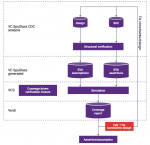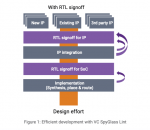I had the opportunity to preview an upcoming webinar from Synopsys on SoC Glitch Power – what it is and how to reduce it. There is some eye-opening information in this webinar. Glitch power is a bigger problem than you may think and Synopsys has some excellent strategies to help reduce the problem. The webinar is available via replay… Read More
The Problem with Reset Domain Crossings
Design complexities in reset, like everything else in big SoC designs, has become incredibly complex, for all sorts of reasons. Long, long ago reset was something you just did once, when you turned the power on. Turn on, then hold reset for some amount of time until everything is in a known starting state, and off you go. Nice and simple.… Read More
What’s New in CDC Analysis?
Synopsys just released a white paper, a backgrounder on CDC. You’ve read enough of what I’ve written on this topic that I don’t need to re-tread that path. However, this is tech so there’s always something new to talk about. This time I’ll cover a Synopsys survey update on numbers of clock domains in designs, also an update on ways to… Read More
SpyGlass Gets its VC
It’s a matter of pride to me and many others from Atrenta days that the brand we built in SpyGlass has been so enduring. It seems that pretty much anyone who thinks of static RTL checking thinks SpyGlass. Even after Synopsys acquired Atrenta, they kept the name as-is, I’m sure because the brand recognition was so valuable.
Even good… Read More
Prevent and Eliminate IR Drop and Power Integrity Issues Using RedHawk Analysis Fusion
I had the opportunity to preview an upcoming SemiWiki webinar on IR drop and power integrity. These topics, all by themselves, have real stopping power. Almost everyone I speak with has a story to tell about these issues in a recent chip design project. When you combine hot topics like this with a presentation that details the collaboration… Read More
Achieving Design Robustness in Signoff for Advanced Node Digital Designs
I had the opportunity to preview an upcoming webinar on SemiWiki that deals with design robustness for signoff regarding advanced node digital designs (think single-digit nanometers). “Design robustness” is a key term – it refers to high quality, high yielding SoCs that come up quickly and reliably in the target system. We all… Read More
Navigating Memory Choices for Your Next Low-Power Design
Choosing a memory architecture can be a daunting task. There are many options to choose from, each with their own power, performance, area and cost profile. The right choice can make a new design competitive and popular in the market. The wrong choice can doom the whole project to failure.
Vadhiraj Sankaranarayanan, senior technical… Read More
Hybrid Verification for Deep Sequential Convergence
I’m always curious to learn what might be new in clock domain crossing (CDC) verification, having dabbled in this area in my past. It’s an arcane but important field, the sort of thing that if missed can put you out of business, but otherwise only a limited number of people want to think about it to any depth.
The core issue is something… Read More
Edge Computing – The Critical Middle Ground
Ron Lowman, product marketing manager at Synopsys, recently posted an interesting technical bulletin on the Synopsys website entitled How AI in Edge Computing Drives 5G and the IoT. There’s been a lot of discussion recently about the emerging processing hierarchy of edge devices (think cell phone or self-driving car), cloud… Read More
How Good is Your Testbench?
I’ve always been intrigued by Synopsys’ Certitude technology. It’s a novel approach to the eternal problem of how to get better coverage in verification. For a design of any reasonable complexity, the state-space you would have to cover to exhaustively consider all possible behaviors is vastly larger than you could ever possibly… Read More











